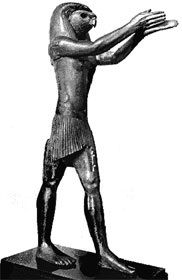The Mother and the Saviour
Next Part “Another Gospel”
Back to The Trinity
Back to By David C. Pack
Semiramis (Easter) was both the mother and wife of Nimrod, described in Genesis 10:8-10, who was the great-grandson of Noah and the original Baal.
In a blatant attempt to rebel against God shortly after the Flood—and the Tower of Babel was built so that civilization would be impervious to “any other flood that God might bring”—history shows that this mother/son duo appointed themselves as gods to be worshipped. History also records that Noah’s son, Shem (Nimrod’s great-uncle), eventually tracked down and killed Nimrod, and sent his body parts throughout his kingdom.
(This is also what happened to Osiris, the “father” in the Egyptian trinity with Horus and Isis.) Semiramis fled for her life, only to return 30 years later with her younger son, Horus (the son in the Egyptian trinity), whom she said was born supernaturally and was the reincarnation of Nimrod—the resurrected saviour! Nimrod was Horus’ supposed father, and Semiramis claimed that she had immaculately conceived him. She also claimed that she came from the moon in a giant egg that fell into the Euphrates river and that this occurred after the spring equinox on the first full moon.
This moon egg was known as Ishtar’s (pronounced Easter’s) Egg. She reinstituted worship of herself and Nimrod, calling herself the mother of god and queen of heaven, among other things by saying that Nimrod symbolized the sun as it “died” during the long cold winter. She also taught that Nimrod was resurrected, and that his son Horus was resurrected to join him in heaven, and Nimrod’s resurrection was represented by the sun returning each spring to warm the earth and renew life. While there is much more to the story than can be included here, Semiramis’ new “mystery system” eventually spread to all the peoples of the earth, as the earlier sources reveal. (The reader should consider reading our two booklets The True Origin of Easter and The True Origin of Christmas to understand much, much more.)
 Horus, the Egyptian version of Nimrod’s son.
Horus, the Egyptian version of Nimrod’s son.
Now notice this quote from the Creation Epic, speaking of Nimrod, the original “savior” of the world: “As for us, by however many names we call him, he is our god! Let us proclaim his 50 names…”
Here are a few of them from history, many of which God condemned Israel for having followed: Nimrod, Molech, Chemosh, Baal, Milcom, Bacchus, Dagon, Osiris, Saturn, Adonis, Cupid, Apis, Volcon, Attis, Kronos and Tammuz, the son in the Babylonian trinity with Ninas (Nimrod) and Ishtar (Easter). (Ezekiel 8:14-16 directly connects Tammuz—the resurrected son of, and reincarnation of, Nimrod—to sunrise services and sun worship, which God calls there an abomination.)
It can now be better understood why the apostle Paul wrote the Corinthians to beware of the subtle deceit of “another Jesus whom we have not preached.” The original apostles understood that “another” very different “Jesus” whom they had “not preached” had existed for millennia.
Bible “believers” today can think that they are worshipping the true Saviour when they are really worshipping a false saviour—another Jesus! The entirety of traditional Christianity is actually worshipping Baal, the mediator and sun god, who was named after his “wife” Ishtar (who we have seen was really his mother Semiramis).
The modern mother/child “Mary/Jesus” emphasis, including the worshipful adoration of Mary by millions, is a parallel with Semiramis and Nimrod that cannot be missed.
People can worship in ways that represent things that are far different than what they sincerely believe or intend. Grasp what is at stake with another Jesus. With a different saviour and “Jesus,” ultimately comes a different “mediator, high priest, shepherd, bishop of our souls, apostle, king of kings, lord of lords,” and all of the other of Christ’s titles and functions.
The problem is that when one leaves “simplicity in Christ” (II Cor. 11:3), the inevitable result is to soon be unwittingly following a very different Christ (II Cor 11:4). But the problem is actually even worse than this.
Paul spoke of “another gospel” and “another spirit,” appearing in conjunction with this other “Jesus.” Therefore, we must next examine a combination of several related questions, including: What is the gospel? Is Jesus part of it? And what is the Body of Christ?
We will also tie all of this to which spirit has been guiding the religions and churches of the world!
“Another Gospel”
First let’s address the question of what is the gospel. Almost everyone believes that the gospel is about the Person of Jesus Christ. Preachers speak incessantly of “Jesus,” His “blood” and His “sacrifice.” Certainly, the true Jesus Christ plays an extremely important and central role to Christianity, but He is not the gospel. The Bible shows that Jesus is preached in conjunction with the gospel. Again, His role is enormous. But He is not the gospel.
It is important to take some extra time at this point to make very plain the clear distinction between the role of Christ and what is the true gospel. Much more is at stake here than meets the eye—and virtually all professing Christians have been badly fooled on what is the very centrepiece of the entire Bible! It is critical that the reader understand how all of this is connected to both another “Jesus” and another “spirit.”
While there are a variety of gospels invented and taught by men, far and away the most popular is the one that centres on the person of Jesus. But if the gospel is not Christ Himself, what is it?

